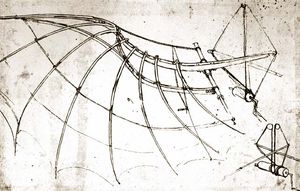It is no surprise that humanity’s first attempts at human powered flight were based on birdlike structures. The first proposed reasonable flying device was proposed by the prodigious artist and engineer Leonardo Da Vinci in 1490 and consisted of a giant bat-looking aircraft that used the pilot’s arms and legs to power the wings.
However, “human-powered wing-falpping flight” is such a complex concept, that engineers have not yet been able to completely master it. For centuries scientists have made multiple efforts to achieve this feat, yet the only successful attempt was made in 2010 by Todd Reichert, an engineering PhD candidate at the University of Toronto Institute for Aerospace Studies (UTIAS). His qualified team was able to design a flapping aircraft that sustained flight for 19.3 seconds over an altitude of 475 feet “achieving the age-old aeronautical dream of self-powered flapping wing flight.”
The extraordinary Snowbird, constructed from carbon fiber and balsa wood, weighs just 94 pounds and has a wingspan of 104 feet. “It was such a neat feeling…you kept pushing and it kept maintaining altitude,” Reichert expressed. “All of a sudden, it clicked and we were able to stay up there.”
So, how does it work?
To achieve flight on the limited power of human energy, the aircraft has to be designed to fly at a relatively slow speed. For that, the wingloading must be decreased by using incredibly large wings and an extremely light structure.“To help support the light structure, external wire bracing is typically used for it favours a hanging fuselage design, which is typical for human-powered aircraft. In the case of a human-powered ornithopter, the bracing wires are additionally used to pull the wing down during the thrusting portion of the stroke.” Unlike planes, the ornithopter’s wings must generate both lift, to overcome the weight of the aircraft, and thrust, to counteract the body drag. Lift is produced the conventional way, by deflecting air downwards. Yet, thrust generation poses a greater challenge because these machines must be able to produce enough thrust to keep the device at the required forward velocity.This thrust is produced by placing the wing at a lower angle of attack on the upstroke and at a higher angle of attack on the downstroke. As we can see in the figure below, this results in large amount of lift and thrust on the downstroke and significantly smaller amount on the upstroke.
Throughout the stroke the wing must twist and shift to maintain an ideal angle of attack. Achieving the right twist along the entirety of the span is one of the more difficult problems in building a successful ornithopter and has formed the basis of much of the past research at the University of Toronto. In the simple words of the creator “It works by pumping a set of pedals attached to pulleys and lines that make the wings flap,” Reichert says. When the pilot pushes the pedals, the go down, and aerodynamic forces pull them back up, creating the thrust.
Nonetheless, further theoretical and experimental research is greatly needed in order to truly master this concept. The snowbird relied on a tow to launch itself into the air and was able to sustain flight for a very limited time period. As the team stated on their news article, “As the first iteration, there are many, many areas that could be improved including decreased weight and greater propulsive efficiency through better wing kinematics. We look forward to future iterations, whether designed by us, or by another team of inspired and dedicated individuals!”
Sources:
- Chronister, Nathan. “The Ornithopter Zone – Fly Like A Bird – Flapping Wing Flight.” The Ornithopter Zone – Fly Like A Bird – Flapping Wing Flight. Nathan Chronister, n.d. Web. 26 Sept. 2012. .
- “A Brief History of Human Powered Aviation and Ornithopters.” HPO Team News. N.p., n.d. Web. 26 Sept. 2012. .
- Johnson, Caleb. “First Human-Powered Ornithopter Flight Recorded by Canadian.”Switched. N.p., 23 Sept. 2010. Web. 26 Sept. 2012.
- “Technical Info.” HPO Team News. N.p., n.d. Web. 26 Sept. 2012. .
- “HPO Team News.” HPO Team News. N.p., n.d. Web. 26 Sept. 2012.

One Comment
Lorena Barba posted on September 28, 2012 at 9:40 pm
You forgot to tell us how recent this is!
In any case, they flew less than 20 seconds, so it looks like this concept has a long way to go.
I wonder how the flight efficiency of the flapper compares with other human-powered aircraft like the Gossamer Condor …